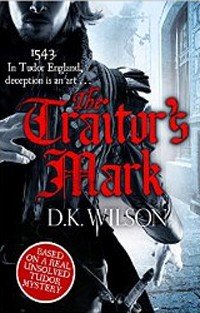1543 and Tudor England is a dangerous place to be. London has a plague, and elsewhere the English Reformation is creating intrigue and suspicion. In his prime Henry VIII threw off the papal yoke with the Dissolution of the Monasteries, but now he’s nearing the end of his life and is physically and mentally infirm. His court is divided along sectarian lines, with many secretly viewing the Church of England as a Lutheran heresy while still trying to gain influence with his majesty. A power struggle is also going on in the counties, with local clergy persecuted by both sides as they fight to determine which version of the Bible should be preached.
Kentish goldsmith Thomas Teviot is pulled into this viper’s nest when his apprentice Bart is arrested at the scene of a murder. Treviot has employed the German artisan Hans Holbein, one of the Henry VIII’s jewellers, to design a piece for an important commission and the normally reliable German has not delivered. Bart is dispatched to his house, only to find Holbein is missing and his employee has been murdered. When Bart flees the scene, convinced that a young man of poor social standing has no chance of a fair trial, Teviot is forced to look for him and Holbein. When his efforts to locate he artist at the German merchants’ guild prove fruitless, Teviot has to follow other leads. Bart has sent a message that a gang of men murdered Holbein’s worker, and Teviot is soon on the trail of the mysterious Black Harry, a bandit and sadist who fled Spain after the Inquisition finished.
It becomes apparent that Black Harry is responsible for the disappearance of several prominent Reformists, and Teviot’s failure to locate him suggests he is using an estate owned by a member of the Kentish gentry. So our jeweller hero cannot help getting caught up in the political intrigue as the Archbishop Thomas Cranmer becomes aware of his actions and inducts him to the Reformist cause.
DK Wilson is a historian who is writing a series of mysteries which provide fictional solutions to genuine historical mysteries. His debut, The First Horseman, was also a Tudor mystery. As might be expected, the author is very comfortable writing about this period and knows how to illuminate history for the average reader without too much exposition. Where he fares less well however, is in structuring the mystery. In The Traitor’s mark, Teviot seems too much of an everyman and this leaves him a little bland – a capital offence for a character who is the lead across the series. The plotting could have benefited from some tighter editorial control, with Teviot and his entourage making too many repetitive trips back and forth from his county seat to his London household. This would have been a better book with 50 pages trimmed from it.
Overall, it’s an interesting read – more from a historical perspective than anything else – and one that fans of period mysteries may well enjoy.
Sphere
Print/Kindle/iBook
£6.99
CFL Rating: 3 Stars
